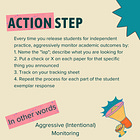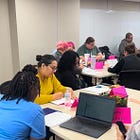Stop starting with modeling. Start with independent practice.
Why it’s one of the most underrated shifts in instructional coaching
If you ask a coach to help a teacher improve instruction, chances are their first instinct will be to model. It makes sense—it feels like the purest form of help: “Let me show you what this looks like.” And modeling definitely has a place.
But when we overemphasize modeling and underemphasize the craft of facilitating strong independent practice, we miss the real heart of learning.
Teaching is not the same as talking.
It’s easy to conflate delivering instruction with producing learning. But learning doesn’t crystallize when the teacher is modeling. It happens when students try it themselves—when they wrestle with the problem, apply the strategy, and make meaning on their own terms.
That’s why in coaching, our ultimate goal shouldn’t just be “Can the teacher model this strategy?” but:
“Can the teacher set up and sustain independent practice in a way that stretches students and deepens thinking?”
Why We Prioritize Coaching Independent Practice
1. Because learning happens during the doing, not the watching
Students don’t get smarter by watching a teacher solve a problem—they get smarter when they solve it themselves. We want teachers to tighten the model and expand the work time.
2. Because students often come in more capable than we assume
We’ve all seen it: a teacher spends 15 minutes modeling something that kids could have started trying after 5. When we over-model, we unintentionally send the message that students can’t problem-solve or learn through productive struggle. But many students bring in partial skills, strategies, and flexible thinking—they just need space to use them.
A better question for coaching is:
“What if you modeled less, and let them show you what they already know?”
3. Because it’s harder than it looks
Facilitating meaningful independent practice isn’t the easy part—it’s the art. Teachers have to make dozens of micro-decisions:
When to step in and when to step back
How to circulate with purpose
Who needs scaffolding and who needs a nudge
How to prompt students without stealing the thinking
How to collect data of student learning and analyze trends
That’s where coaching can do its best work. Not in showing a perfect model—but in rehearsing the moves that support deep, productive independent work.
4. Because real life doesn’t come with a model
When students take a test, tackle a new genre, or solve a novel problem, they won’t get a teacher-led “I do” first. They have to rely on their skills, strategies, and habits of mind.
So let’s coach teachers to prepare students for that reality. That means gradually releasing responsibility, creating space for students to struggle, and building a classroom culture where independent work is where the magic happens.
5. Because it helps students and teachers unlearn the
“I’m Finished” mindset
If there’s one classroom habit that undercuts deep learning more than almost anything else, it’s the idea that learning is over when the task is done.
“I’m finished.”
“I did the ten problems.”
“What do I do now?”
This mindset shows up across grade levels, and it’s not just a student issue—it’s a system issue. For years, we’ve conditioned students to believe that completing a worksheet equals learning, and that speed is a proxy for intelligence.
But when we coach teachers to prioritize effective independent practice, we help dismantle that narrative.
How Get Better Faster from Uncommon Schools Positions Independent Practice as the Main Event
Get Better Faster is a teacher development framework created by Paul Bambrick-Santoyo and Uncommon Schools. It offers a high-leverage coaching model built on the belief that new teachers (and those refining their craft) don’t need to master everything at once—they need to master the most important things first.
It’s structured in phases, each aligned to a carefully sequenced set of teacher moves that drive classroom management and rigor. One of its core ideas is this: great teaching isn’t defined by how well you talk—it’s defined by what students can do on their own.
Independent Practice in GBF: A Coachable Skill, Not Just a Lesson Component
By Phase 2 (Days 1–30), Get Better Faster positions independent practice as a vital area for coaching. It’s not filler. It’s not just "work time." It’s the main event—the place where student learning becomes visible and teacher impact becomes measurable.
Teachers are coached to:
Script an exemplar of what a high-quality response looks like
Establish regular routines for independent work
Circulate with intention, checking work against the exemplar, coding errors, and prompting real-time revisions
In other words, GBF turns independent practice into an active coaching zone. It’s where students show what they understand—and where teachers learn the most about their own effectiveness.
Prioritizing Independent Practice Is the Thing
It’s not the warm-up.
It’s not what’s left over if we finish the mini-lesson early.
It is the instructional core.
When we coach for it—really coach for it—we reorient classrooms around student thinking, not teacher delivery.
Effective independent practice:
Uncovers gaps in instruction
Gives students the reps they need to build mastery
Trains teachers to gather and respond to real-time data
Shifts the classroom culture from compliance to intellectual ownership
The Coaching Shift
Instead of spending the majority of our time perfecting the model or scripting teacher talk, we coach teachers to ask:
“What will students be doing once they start working?”
“How will the task stretch their thinking—not just check their accuracy?”
“What do we want students to do after they get an answer?”
“What is the exemplar?”
“Can students do it—and can they explain why?”
That’s where the real instructional leverage is. That’s where we break the “I’m finished” habit—not through motivation posters or early-finisher packets, but through the design and facilitation of powerful independent work.
Bottom Line
Modeling feels like teaching. But if we stay there, we coach teachers to perform, not to empower. The true test of great instruction isn’t how clearly the teacher explains—it’s how deeply students engage in the work.
Independent practice isn’t just a part of the lesson.
It’s the part where learning sticks.
When we coach teachers to treat it as the main event—not an afterthought—we don’t just improve classroom instruction; we build student habits that last far beyond the lesson: persistence, curiosity, metacognition, and the belief that there’s always more to explore.
And that’s the mindset that matters.










